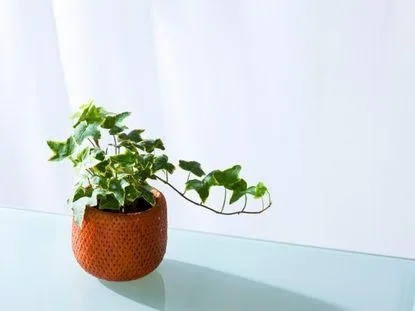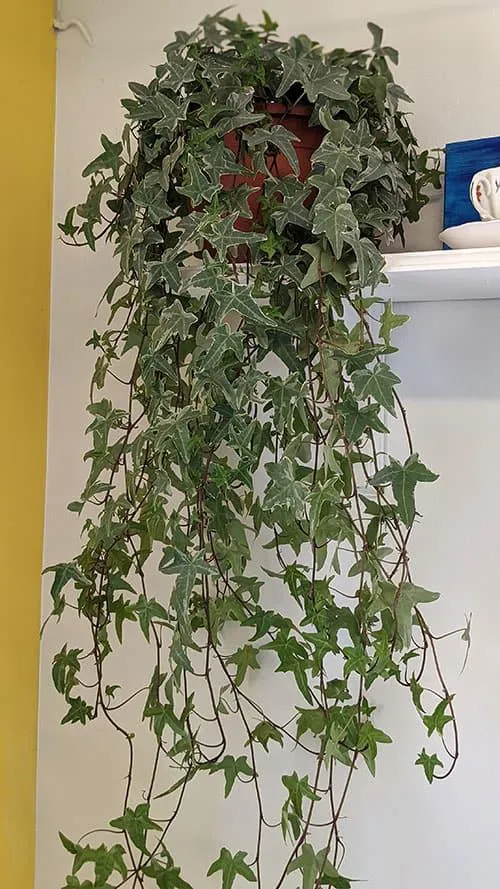Everything You Need to Know About English Ivy as an Indoor Houseplant
Have you been thinking about adding some greenery to your home but aren’t sure where to start? English ivy may be the perfect low-maintenance indoor plant for you. As one of the most common houseplants, English ivy is beloved for its ability to thrive with little sunlight and infrequent watering.
History and Fun Facts
English ivy (Hedera helix) has a long history of being used both indoors and outdoors. Dating back to ancient Roman times, ivy was seen as a symbol of friendship and fidelity. From my experience volunteering at botanical gardens, I’ve learned ivy is actually classified as a deciduous woody vine instead of a true houseplant! Kind of weird when you think about it hanging out in pots. Did you know it’s also commonly called Atlantic ivy, or California ivy on the west coast? Not sure where the California name came from since it’s native to Europe and Asia.
Choosing an English Ivy Plant
When selecting an English ivy plant for your home, you’ll find them available in several different forms. The classic trailing variety grows long stems that can cascade over the edges of furniture or plant stands. Basically your basic ivy! If space is limited, look for compact cultivated varieties bred to stay bushier. Some interesting ivy cultivars have variegated white or yellow foliage for added visual interest. No matter the variety, go for healthy dark green leaves and avoid any plants showing signs of disease or pests.
Light and Water Requirements
- Light: English ivy thrives in low to medium light conditions and tolerates moderate shade well. It will survive with as little as four hours of indirect sunlight daily. Basically, if your home doesn’t get a ton of natural light, ivy is a great option.
- Water: Allow the soil to dry out somewhat between waterings, but don’t let it become bone dry. During active growth periods, water when the top inch of soil feels dry. In the winter when growth slows, water just enough to keep the soil slightly moist.
I’ve found from experience that English ivy is pretty forgiving if you sometimes forget to water on schedule. It’s survived weeks of my neglect! At the same time, overwatering can cause root rot, so using your finger to check the soil depth is important.

Humidity and Fertilizer
While English ivy thrives with average indoor humidity levels, it may appreciate occasional misting. Peep this pro tip – group ivy with other houseplants to create a mini jungle and raise the overall humidity for all the plants. Kinda like how The Brady Bunch would all hang out together in the den! Fertilize during spring and summer with a dilute, water soluble houseplant fertilizer. I swear by the citrus-scented Miracle-Gro for an easy pick. Scale back fertilizing in fall and winter when growth slows.
Pruning and Plant Care
Prune off any non-vining stems to keep the plant bushy. You can also prune to control size or shape as desired. I usually lop mine back after a growth spurt in spring. Snip off any totally dried-out or discolored foliage with clean pruners or scissors. Repot ivy planted in a container only when roots have completely filled the pot. Use a well-draining potting mix suitable for houseplants. Shake or tip the plant to check for soil that has become compressed over time. Experienced gardeners know well-meaning advice about dividing can be more trouble than it’s worth. If it ain’t broke, don’t fix it!
Over the years, pests have rarely been an issue for my English ivy. But mealybugs, spider mites or scale can sometimes affect indoor plants. Check periodically for any critters. A damp cotton ball dabbed with rubbing alcohol works well for small infestations. As a last resort, neem oil or insecticidal soap can safely treat moderate problems. But from my experience, prevention through regular inspections is usually enough.
Placing English Ivy Around the Home
English ivy lends itself to a variety of creative applications inside the home. The trailing form looks amazing draped over bookcases, hanging baskets or winding up a moss pole. I once knew a guy who trained his all around the tops of books on his shelves – it was totally amazing. Stake individual stems emerging from a pot to guide vertical growth up a support or trellis. Speaking of support, make sure pots placed high up have some weight too them – that ivy can get heavy!

Cluster pots of ivy amongst other foliage plants on shelving, tables or the mantel for an instant indoor garden vibe. Try lining a picture ledge, winding stems around curtain rods or weaving it in and out of a metal or rattan headboard above the bed. With some creative positioning, English ivy adds lush foliage pretty much anywhere. Over the years I’ve become really fond of my collection and enjoy nurturing their growth.
Propagation
English ivy readily propagates from stem cuttings, allowing you to expand your collection. Sometime in mid-spring or early summer, snip 4-6 inch sections from non-flowering mature stems. Remove leaves from the bottom half of each cutting and place the bare stems in a jar of water. Within a few weeks, roots will start to form. Pot up the young plants in potting mix once an established root system develops. My cuttings usually root within 1-2 months sitting in a sunny windowsill. This is basically the easiest plant to multiply for free. Every little stem you snip off will potentially become a brand new ivy plant!
Wrapping Things Up
In conclusion, English ivy makes a wonderful choice for beginning or forgetful plant parents. Its ability to thrive with low light and infrequent care earns it the nickname “the forgiving plant”. Despite rumors of being poisonous, English ivy is non-toxic to humans unless directly eaten in large quantities. So feel free to let kids interact with it. At the end of the day, ivy adds soft texture and living art to any indoor space. It’s always been a home staple for me. Whether you started with one sad little ivy in a four inch pot or built a full-fledged collection over the years, I hope this guide helped you grow to love English ivy too! Let me know if you have any other questions.

English Ivy Indoor Plant Care Tips
| Type | Watering Needs | Light Requirements | Humidity | Growth Rate |
|---|---|---|---|---|
| Hedera helix | Keep soil moist but not soggy. Water when top inch of soil is dry. | Moderate to bright indirect light. | Prefers humidity above 50%. Mist leaves occasionally. | Slow, vines can reach 10 feet given space to climb. |
| Hedera helix ‘Baltica’ | Water same as regular ivy. Allow soil to dry slightly between waterings. | Tolerates low light but grows fastest in bright indirect light. | Humidity above 50%. | Faster growth rate than regular ivy, vines can reach 15 feet. |
| Hedera helix ‘Needlepoint’ | Water same as regular ivy. Do not overwater. | Low to bright indirect light. | Prefers humidity above 50%. | Compact growth, vines stay under 3 feet. |
| Hedera helix ‘Gold Child’ | Water same as regular ivy. Allow soil to partly dry between waterings. | Moderate to bright indirect light for vibrant variegated leaves. | Humidity above 50%. | Moderate growth rate, vines can reach 6-10 feet. |
FAQ
-
How do I care for english ivy as an indoor plant?
English ivy needs bright, indirect sunlight and moderate watering. Water when the top inch of soil becomes dry. English ivy flourishes better in humid conditions, so mist the leaves occasionally or place the pot on a pebble tray with water. Repot into a slightly larger pot once the roots fill the container. Fertilize in spring and summer. English ivy is basically low maintenance and does well in average household conditions.
-
What kind of soil and pot do english ivy prefer?
English ivy grows great in common potting mixes. Choose a pot with good drainage holes at the bottom. Terracotta or plastic works well. Perhaps a hanging basket or wall planter displays english ivy nicely due to its trailing vines. Still, a simple container on a table or windowsill lets its foliage cascade over the sides. Airy, well-draining soil prevents root rot, which can be awful for any plant.
-
How fast does english ivy grow?
English ivy is an energetic grower that can spread quite quickly, both as a houseplant and outdoors. Its vines may increase by several inches per month during active growth periods in spring and summer. However, growth may slow somewhat in winter with less light. Give the plant something to climb or trail on to guide its upward or outward progress. Before you know it, a small english ivy can morph into a lush hanging plant or groundcover.
-
What are the benefits of english ivy as a houseplant?
English ivy has some stunning properties that make it a lovely indoor plant. Its subtle green leaves and gracefull vines create beauty. English ivy also gives off moisture, helping humidity levels in dry indoor areas. Some studies show it may boost air quality by removing toxins like formaldehyde. Its low sunlight needs mean english ivy thrives in darker corners. On the other hand, its adaptability means placing it near a sunny window suits it too. All in all, english ivy brings life and wellness to living spaces.

-
Does english ivy need pruning or shaping?
For the most part, english ivy grows naturally without much pruning. You can certainly trim off any overly long vines to keep the plant shapely. Pruning stimulates bushier growth. Despite this, many folks leave english ivy to its own devices. It may become thick and full without grooming. Occasionally remove withered or dying stems to maintain a compact size. During spring, consider pinching back new growth to encourage branching. But light trimming now and then should suffice to manage this low-maintenance indoor vine.
-
Are there any pests or diseases to watch for with english ivy?
Generally english ivy faces few issues when grown as a houseplant. However, signs of pests or illnesses shouldn’t be disregarded. Mealybugs sometimes affect english ivy, looking like fluffy white specs. Scale insects appear as hard, stuck-on circles or ovals. Both feed on plant juices, weakening the ivy. Take action quickly by spot-treating with insecticidal soap. Likewise, watch for leaf spots or yellowing, which may signal root rot from overwatering or poor drainage. In such cases, change the soil and cut back severely. With diligence, english ivy can be kept pest-free and in good condition indoors.
-
Can english ivy be propagated from cuttings?
Yes! English ivy roots effortlessly from stem cuttings. Simply remove 4-6 inch snippets from hanging or trailing vines. Strip the bottom leaves. Place the cut ends in water until roots emerge, which appears in a few weeks. Then plant in potting soil. Keep the soil lightly moist as new growth develops. Before long, you’ll have multiple ivy plants from only one parent. This allows english ivy to be shared or “cloned” amongst friends. But remember, too much ivy may become quite the jungle in the house!
